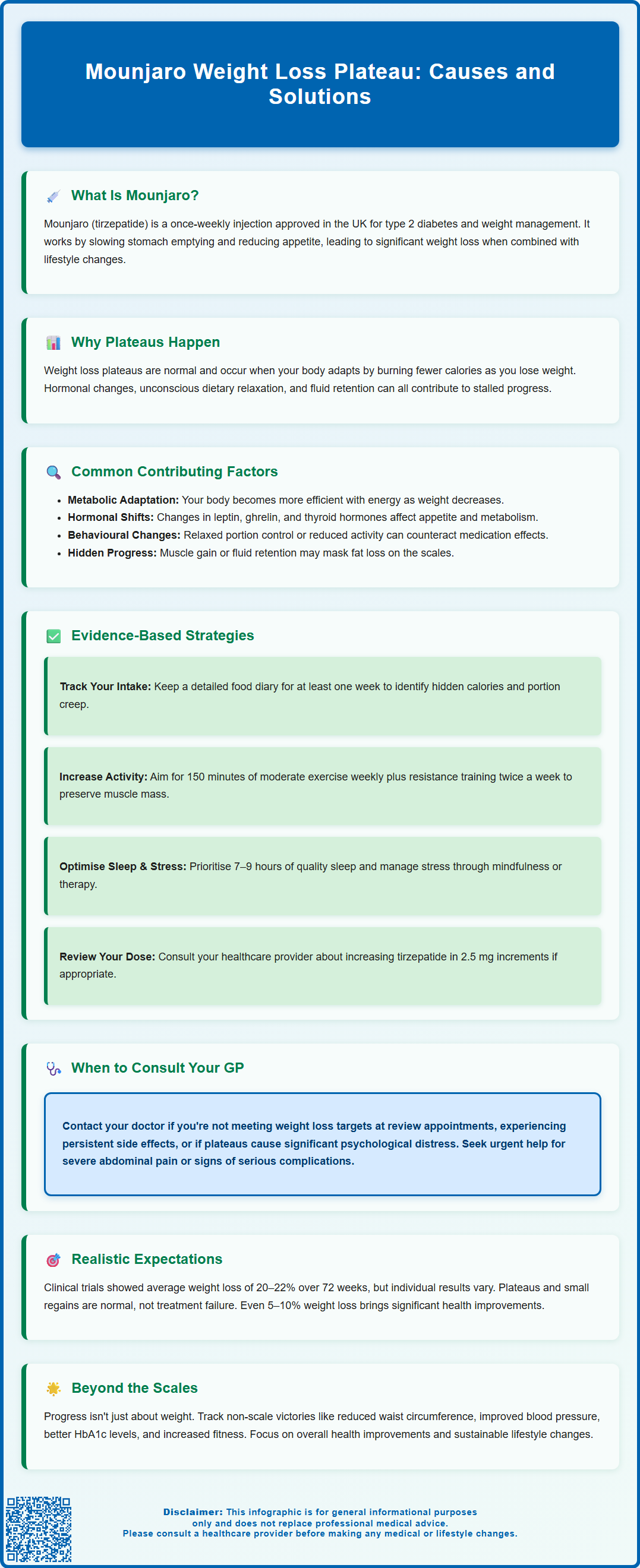Wegovy®
A weekly GLP-1 treatment proven to reduce hunger and support meaningful, long-term fat loss.
- ~16.9% average body weight loss
- Boosts metabolic & cardiovascular health
- Proven, long-established safety profile
- Weekly injection, easy to use

Experiencing a weight loss plateau whilst taking Mounjaro (tirzepatide) is a common and often frustrating challenge. After an initial period of steady progress, many patients find their weight stabilises despite continued medication adherence and lifestyle efforts. Understanding why plateaus occur—from metabolic adaptation and hormonal changes to behavioural factors—is essential for overcoming them. This article explores evidence-based strategies to restart weight loss, when to seek medical advice, and how to set realistic expectations for long-term success with tirzepatide treatment in the UK.
Summary: A Mounjaro weight loss plateau occurs when progress stalls after initial weight reduction, typically due to metabolic adaptation, hormonal changes, and behavioural factors rather than medication failure.
Mounjaro (tirzepatide) is a once-weekly injectable medication licensed in the UK for the treatment of type 2 diabetes. Tirzepatide is also authorised for weight management in adults with obesity or overweight with weight-related comorbidities, though this may be marketed under a different brand name. It belongs to a novel class of medicines known as dual glucose-dependent insulinotropic polypeptide (GIP) and glucagon-like peptide-1 (GLP-1) receptor agonists.
The weight loss effects of tirzepatide are multifactorial. It initially slows gastric emptying, though this effect may attenuate over time with continued treatment. More importantly, tirzepatide acts on areas of the brain involved in appetite regulation, leading to decreased hunger and reduced energy intake. In the SURMOUNT clinical trials, participants using the highest dose (15 mg) achieved an average weight loss of approximately 15–20% of their initial body weight over 72 weeks when combined with intensive lifestyle support.
In the UK, tirzepatide for weight management is available only through specialist weight management services, with specific eligibility criteria including BMI thresholds (with lower thresholds for some ethnic groups) and weight-related comorbidities. NICE guidance specifies continuation criteria and typically limits treatment duration to up to 2 years. The medication must be initiated and monitored by healthcare professionals.
It is important to recognise that tirzepatide is not a standalone solution; it works most effectively when integrated into a comprehensive approach that includes dietary changes, regular exercise, and behavioural support. Individual responses vary, and ongoing medical supervision is essential to optimise outcomes and manage any adverse effects.
A weight loss plateau is a common and often frustrating experience for individuals using tirzepatide. This phenomenon typically occurs after an initial period of steady weight reduction, when progress appears to stall despite continued adherence to medication and lifestyle measures. Understanding the underlying reasons for plateaus can help patients and clinicians address them more effectively.
One key factor is metabolic adaptation. As body weight decreases, the body's energy expenditure naturally declines because there is less mass to maintain. This reduction in basal metabolic rate means that the calorie deficit that initially led to weight loss becomes smaller over time, slowing further progress. Additionally, hormonal changes—including alterations in leptin, ghrelin, and thyroid hormones—can influence appetite and energy balance, making continued weight loss more challenging.
Behavioural factors also play a significant role. After initial success, some patients may unconsciously relax their dietary vigilance or reduce physical activity levels. Portion sizes may gradually increase, or higher-calorie foods may be reintroduced. Even small deviations from a structured eating plan can accumulate and offset the effects of the medication. It is also worth noting that weight fluctuations due to fluid retention, menstrual cycle changes, or increased muscle mass from exercise can mask fat loss on the scales.
Finally, while pharmacological tolerance might be considered, there is no established evidence linking prolonged tirzepatide use with reduced efficacy. The attenuation of gastric emptying effects over time is recognised in regulatory assessments, but the central appetite-regulating effects appear to be sustained. Plateaus are a normal part of the weight loss journey and do not necessarily indicate treatment failure. Recognising these factors allows for targeted interventions to reinvigorate progress.

Overcoming a weight loss plateau while on tirzepatide requires a multifaceted, evidence-based approach that addresses both physiological and behavioural factors. The following strategies are supported by clinical guidance and can help restart progress.
Reassess dietary intake: Keeping a detailed food diary for at least one week can reveal hidden sources of calories or portion creep. Focus on nutrient-dense, low-calorie foods such as vegetables, lean proteins, and whole grains. Reducing ultra-processed foods and added sugars can create a renewed calorie deficit. Consider consulting a registered dietitian for personalised advice aligned with your weight loss goals.
Increase physical activity: Incorporating both aerobic exercise and resistance training can boost energy expenditure and preserve lean muscle mass. The UK Chief Medical Officers' Physical Activity Guidelines recommend at least 150 minutes of moderate-intensity activity per week, plus muscle-strengthening activities on at least two days per week. Resistance training is particularly valuable as it helps counteract the decline in metabolic rate associated with weight loss.
Optimise medication dosing: If you have been on the same dose for an extended period and have reached a plateau, discuss with your healthcare provider whether dose escalation is appropriate. Tirzepatide should be titrated in 2.5 mg increments no sooner than every 4 weeks, based on tolerability and response, up to a maximum of 15 mg. Any dose changes must be supervised by your prescribing clinician.
Address sleep and stress: Poor sleep quality and chronic stress can disrupt hormones that regulate appetite and metabolism, including cortisol and insulin. Aim for 7–9 hours of quality sleep per night and consider stress-reduction techniques such as mindfulness, yoga, or cognitive behavioural therapy.
Monitor non-scale victories: Weight is not the only measure of success. Improvements in waist circumference, blood pressure, HbA1c, lipid profiles, and overall fitness are important indicators of health progress. Celebrating these achievements can maintain motivation during a plateau.
While weight loss plateaus are common, there are specific circumstances when it is important to consult your healthcare provider to ensure safe and effective treatment.
You should seek medical advice if:
Insufficient weight loss at review points: NICE guidance specifies continuation criteria for tirzepatide in weight management. Your specialist will assess your progress at predetermined intervals and determine whether treatment should continue based on weight loss achieved and improvement in comorbidities.
Significant adverse effects: Common side effects include nausea, vomiting, diarrhoea, constipation, and abdominal discomfort. While these often improve over time, persistent or severe gastrointestinal symptoms warrant medical review. If you experience severe vomiting or diarrhoea, seek urgent advice as there is a risk of dehydration and acute kidney injury. Rare but serious adverse effects—such as pancreatitis (severe, persistent abdominal pain), gallbladder disease, or signs of thyroid tumours (neck lump, hoarseness, difficulty swallowing)—require urgent assessment.
Hypoglycaemia symptoms: Although tirzepatide has a low intrinsic risk of hypoglycaemia, patients taking it alongside other glucose-lowering medications (such as insulin or sulphonylureas) may experience low blood sugar. Symptoms include sweating, tremor, confusion, and palpitations. Dose adjustments of concomitant medications may be necessary.
Diabetic retinopathy concerns: If you have diabetes with existing retinopathy, rapid improvement in blood glucose control may temporarily worsen eye complications. Regular eye monitoring is essential.
Psychological concerns: If weight loss plateau leads to significant distress, disordered eating behaviours, or low mood, it is important to discuss these with your healthcare provider. Referral to psychological support services may be beneficial.
Pregnancy or planning pregnancy: Tirzepatide should be discontinued at least one month before a planned pregnancy. If you are planning to conceive, discuss discontinuation and alternative management strategies with your healthcare provider.
If you experience any suspected side effects, report them via the MHRA Yellow Card scheme (yellowcard.mhra.gov.uk). Regular follow-up appointments are an integral part of treatment, allowing for monitoring of weight, metabolic parameters, and overall wellbeing.
Setting realistic expectations is crucial for long-term success and satisfaction with tirzepatide treatment. While clinical trial data are impressive, individual results vary considerably based on baseline weight, adherence to lifestyle measures, genetic factors, and coexisting medical conditions.
In the landmark SURMOUNT trials, participants using the highest dose of tirzepatide (15 mg) achieved an average weight loss of approximately 20–22% of their initial body weight over 72 weeks. However, this was in the context of a structured clinical trial with intensive dietary and behavioural support. Real-world outcomes may differ, and responses vary significantly between individuals.
It is important to understand that weight loss is rarely linear. Periods of rapid loss are often followed by plateaus or even small regains. This does not indicate treatment failure but reflects the body's complex regulatory mechanisms. Sustainable weight management is a long-term endeavour, and maintaining lost weight is as important as the initial reduction.
Non-weight benefits should also be emphasised. Even modest weight loss (5–10% of body weight) can lead to significant improvements in cardiovascular risk factors, glycaemic control in type 2 diabetes, sleep apnoea, joint pain, and quality of life. These health gains are valuable regardless of whether you reach an ideal body weight.
Finally, tirzepatide is not a permanent solution. The SURMOUNT-4 trial demonstrated that if the medication is discontinued, weight regain is common unless lifestyle changes are maintained. In the UK, NICE typically limits treatment duration to up to 2 years within specialist weight management services. Ongoing support from healthcare professionals, dietitians, and behavioural therapists can help sustain long-term success. Realistic goal-setting, patience, and a focus on overall health—rather than the number on the scales alone—are key to a positive experience with treatment.
No, plateaus are a normal part of weight loss and do not indicate treatment failure. They typically result from metabolic adaptation, hormonal changes, and behavioural factors rather than reduced medication efficacy.
Plateau duration varies between individuals. Implementing evidence-based strategies such as reassessing diet, increasing physical activity, and optimising medication dosing under medical supervision can help restart progress within several weeks.
Dose escalation may be appropriate but must only be done under medical supervision. Your healthcare provider will assess whether increasing the dose in 2.5 mg increments is suitable based on your current dose, tolerability, and overall response to treatment.
The health-related content published on this site is based on credible scientific sources and is periodically reviewed to ensure accuracy and relevance. Although we aim to reflect the most current medical knowledge, the material is meant for general education and awareness only.
The information on this site is not a substitute for professional medical advice. For any health concerns, please speak with a qualified medical professional. By using this information, you acknowledge responsibility for any decisions made and understand we are not liable for any consequences that may result.
Lorem ipsum dolor sit amet, consectetur adipiscing elit, sed do eiusmod tempor incididunt ut labore et dolore magna aliqua. Ut enim ad minim veniam, quis nostrud exercitation ullamco laboris nisi ut aliquip ex ea commodo consequat. Duis aute irure dolor in reprehenderit in voluptate velit esse cillum dolore eu fugiat nulla pariatur.
Block quote
Ordered list
Unordered list
Bold text
Emphasis
Superscript
Subscript